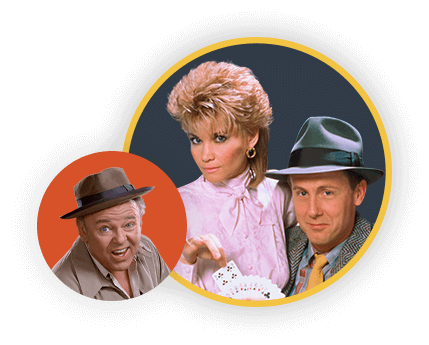1981 was a revolutionary year for television and deserves to be remembered

Teleport a Gen-Z'er back to the Seventies and plop them in front of a television. Aside from not understanding how to operate the thing, the younger generation would be surprised at what they found — or didn't find — on the dial. The primetime lineup primarily stocked sitcoms. Even the hour-long fare like CHiPs and Charlie's Angels were far more lighthearted. Back then, TV aimed to be fun. Today, it more often aims to be serious.
But then time-travel to 1981. Suddenly, the programming seems much closer to the modern age.
Celebrity gossip, prestige dramas, music videos, relatable superheroes, glamorous housewives, irreverent kids programming that adults could enjoy — it all blossomed in 1981 thanks to the following. Let's take a tour.

Hill Street Blues
Dragnet and Adam-12 brought realism to the police procedural, collaborating with an appreciative LAPD and crafting plots straight of their case files. Hill Street Blues took the baton and humanized the men (and, importantly, the women) in blue, imbuing the characters with all the flaws found in antiheroes of Seventies cinema. In this way, it set the mold for ensemble prestige television, paving the way for everything from NYPD Blue to The Sopranos.
Image: The Everett Collection

Dynasty
Before Americans became obsessed with the Real Housewives of Wherever, they turned to the Fake Housewives of Denver. Primetime soap operas were nothing new, but Dynasty draped its drama in diamonds and gold. The show also budgeted enough beauty products and soft lighting to make a perfume commercial drool. Catfights between Krystle (Linda Evans) and Alexis (Joan Collins) were the stuff of modern social media feuds. Dynasty fixated on superwealth, and we never turned back.
Image: The Everett Collection

Entertainment Tonight
In the 1970s, news was… well, news. Politics, natural disasters, home runs, that sort of thing. Then came Entertainment Tonight, which ushered in "tabloid television," bridging the gap between the grocery checkout and the modern internet. ET treated Hollywood as the center of the universe, turning media into an ouroboros of pop culture self-promotion. In 1981, the faces behind the desk included Ron Hendren, pictured here. Mary Hart would join in 1982, Leeza Gibbons would follow a couple of years later. John Tesh, Hart's best-known co-host, brought his enviable hair to the chair in 1986.
Image: The Everett Collection

MTV
What would talk of 1981 television be without MTV? (That's MTV, not MeTV.) The Music Television channel powered up on cable that year, famously kicking its run of music videos with the Buggles' "Video Killed the Radio Star." Forty years later, the era of MTV showing nothing but music videos seems rather brief. It gave that up around, what, halfway through its history?
Image: The Everett Collection

The Smurfs
Cute cartoon characters are not revolutionary in themselves, so what made the Smurfs so special? A couple of things. For starters, they were European in origin, proving that characters from overseas could play big in America. Secondly, this was a cartoon based on a comic series and — crucially — a line of collectible figurines. Really, the cartoon was a commercial for toys, which became the primary function of animation in the 1980s.
Image: The Everett Collection

The Greatest American Hero
Superheroes had been on TV for decades, from the camp crusading of Batman to the groovy heroism of Wonder Woman to the inner rage of The Incredible Hulk. But The Greatest American Hero did a couple of important new things. First, it proved that original creations like William Katt's spandex hero could stand on their own. This was not an established character from DC or Marvel. Also, Ralph Hinkley (later, Hanley) was a relatable everyman like us. Wonder Woman and the Hulk and their like were gods and monsters. Ralph was a substitute teacher. The blend of comedy and comic-book heroics made this a template for the modern Marvel Cinematic Universe.
Image: The Everett Collection

Gimme a Break!
In the 1970s, if a network gave a singer a television show, odds are, it was going to be a variety show. But after the death of the variety show, how were Broadway stars to cross-over? Nell Carter proved that Tony Winners could take home comedy Emmys, too. Naturally, she belted out the theme song to her sitcom, too. Black women had not had much of a chance to headline their own shows. Remember, this is just 13 years after the ceiling-shattering Julia with Diahann Carroll, and seven years following Get Christie Love!, the first network drama centered around a Black woman. Gimme a Break! would run for six seasons.
Image: The Everett Collection

You Can't Do That on Television
Gen-X kids will fondly recall this sketch comedy series, imported from Canada. Kids had had their only television, but nothing like this, an irreverent series modeled after Laugh-In and SNL. This was kids' television but by no means educational. That was important. Its crazy characters and recurring premises (the wise-cracking Alisdaire tied up before a firing squad, disgusting chef Barth, etc.) helped the nascent Nickelodeon network become a destination for tweens and teens. This is the show that also introduced "sliming" to the channel, as green slime would fall from the sky whenever someone said, "I don't know." That green goop became a trademark for Nickelodeon. Oh, and Alanis Morissette was a cast member.
Image: The Everett Collection

…and so much more!
Let's not overlook the other awesome shows that kicked off in 1981, including Lee Majors singing his theme song on The Fall Guy (pictured here), Simon & Simon, Father Murphy, Falcon Crest and Darkroom. Oh, and was 1981 the birth of the reboot? Perhaps! Both Bret Maverick and The Brady Brides premiered that year!
Image: The Everett Collection




